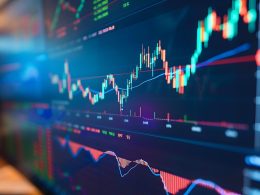by Jurrien Timmer, Director of Global Macro for Fidelity Management & Research Company
Testing Resistance
It’s now week 9 of this correction and the stock market remains in a holding pattern, marked by the impulse low set 2 weeks ago and the April 3 breakdown point (the scene of the crime). So far, it has been a textbook technical picture, with the S&P 500 index churning in between the -10% and -20% correction thresholds and thus far not being able to exceed resistance at 5500.
Should the index be able to take out this resistance level, we may be able to assume that the correction is over and that we only had a “mini-bear,” not unlike 1998 and 2018. Conversely, if we do retest the 4835 low and it doesn’t hold, then a “real” bear market is likely underway, taking us further into the 20-30% correction range. Those are the parameters while we wait for the market’s next move.

The 1998 Analog Still Rules
For now, the 1998 analog continues to hold, and shows a textbook pattern of a normal 10% correction giving way to an impulsive 20% decline, then rebounding but initially failing at the old breakdown point. From there the index retested the lows, held, took out the retracement high, and with the help of three rate cuts from the Greenspan Fed, was off to the races.

Anatomy of a Drawdown
While fundamentally 1998 was quite a different cycle from today, it’s worth noting that the valuation backdrop is similar. At the cycle peak in July 1998 the P/E multiple was 25x, and from there it fell to 20x at the low. A cycle bottom P/E of 20x is historically very high, and I remember that at the time many investors missed a good chunk of the bull market because they couldn’t accept that a new bull could start at such a high multiple. They ended up chasing the bull all the way to its dot.com bubble extreme in 2000. This is why it’s important to take a holistic approach to market analysis, rather than relying solely on earnings and valuation.

Earnings Estimates Are Coming Down (a Tad)
Q1 earnings season is now underway, and while we are not likely to learn too much about the changing landscape, it is clear that the next few quarters are being marked down. The Q2 estimate has already fallen from $68/share to $65/share, which is more than the standard drift.

The markdowns are big enough that even the smoother 12-month estimates are rolling over for 2025, 2026, and even 2027. This makes sense given the changing economic landscape, and fortunately valuations have derated enough (from 25x to 19x) to allow stock prices to withstand some EPS markdowns.

Mag 7 Earnings
Earnings estimates for the Mag 7 are holding up for the most part, but there is some fraying around the edges here as well. If this cohort was still trading at its peak valuation of 40x (February) this might be a problem, but the index has derated more than the broad market and is now trading at a more reasonable 25x.

RoW US Earnings Have Caught Up
And while US earnings growth is at 10% and falling, the EAFE growth rate is at 10% and rising. Improving relative earnings plus a big valuation spread plus crowded positioning argues for a relative performance episode that could last longer than a few months, especially with the weaker dollar adding to performance tailwinds.

The Investment Clock
The parallel to 2018 (Trump’s 2nd year of his first term) continues to play out, with earnings growth being more than offset by P/E compression. The clock below shows the juxtaposition of earnings growth (vertical) and financial conditions (horizontal). We have now landed in the upper right quadrant (earnings up, financial conditions tighter) after spending time in the upper left quadrant (earnings up, financial conditions looser). Even if this was just a “bear scare” and the market recovers all its losses, I expect 2025 to offer little positive momentum following the outsized gains of 2023 and 2024.

A New Cycle, or Just an Interruption?
For now, the unanswered question is whether the 21% drawdown since February is just a squall (like 2018) or the start of a cyclical bear market. We don’t have the answer until the S&P 500 either recovers above 5500 or breaks to new lows below 4835, but considering that the February high marked the 30th month of that cyclical bull (in line with the median bull market) we have to be open to the possibility that a new bear is afoot. That possibility is supported by the monthly Coppock Curve (a momentum indicator) which has just flashed a sell signal similar to what we got at the January 2022 cycle peak.

Credit Showing a Glass Half Full
But there is also good news. For one, credit spreads have narrowed in recent weeks, supporting the more constructive price action in stocks. If spreads were still widening it would be an ominous signal for the economy.

A Bullish Read from Sentiment
Another promising development is sentiment. We know that the usual sentiment surveys (II and AAII) have shown caution, but what investors say is one thing but what they do is another. As such, the Vicker’s insider buying/selling ratio shows that corporate insiders are now buying. That has historically has been a bullish signal.

Bonds Have Stabilized but the Dollar Has Not
Last week was relatively quiet in the markets following the bond storm the previous week. Yields have come down from their recent peak at 4.59% but remain well below their low of 3.98%. The dollar, meanwhile, has decoupled a bit and remains below 100.

Gold Continues to Follow the Money
On the other side of the dollar is gold, which continues to rally to new highs. At $3358, gold is following the global money supply, which now stands at an all-time high of $110.27 trillion (per Bloomberg).

A Fork in the Road for Bonds
In my view bonds remain at a crossroads, caught between a potential Fed easing cycle and a rising term premium. At 71 bps, the term premium is edging closer to a more normal valuation.

A Fed Below Neutral
As for the Fed, Chairman Powell has made it clear that he is no hurry to ease until the Fed sees more conclusive proof that inflation has been tamed once and for all. We are not there yet, so the Fed seems correct in its wait-and-see approach. If a neutral policy is 100 bps above the inflation rate (i.e., 4%), then a moderately accommodative stance might be around 3%. Indeed, this is where the forward curve is now priced. It doesn’t seem unreasonable should the economy weaken from here.

Twilight for the Secular Bull
Given that the cyclical bull market has reached middle age and the secular bull market has reached (in my view) its golden years, it’s worth contemplating what comes next, not only for the next year or two but the next 5-10 years. Following 16 years of above-trend performance dominated by US mega caps, it goes without saying that navigating the secular context is of utmost importance for both the beta (market returns) and the alpha (relative returns from asset classes).
In the chart below I show the analog of the last two secular bull markets, namely 1949-1968 and 1982-2000. There is a sequence to them: the first 10 years have tended to be very robust, producing a rising 10-year inflation-adjusted CAGR well into the double digits. Then, as the negative returns from a decade earlier have rolled off, the rate of change starts to roll over from the mid-teens. The market continues to climb, but the return profile moderates from well above-average to average to eventually below-average.

As the secular trend reaches its eventual end (historically around 18 years), the market enters a secular bear, producing either below-average returns or even negative inflation-adjusted returns for a number of years.
CAPE Model
For the past 12 years I have assumed that the current secular bull market began in 2009 and was confirmed in 2013 (when the S&P 500 index finally surpassed its 2007 high). Not all technicians agree with me on this timing, but as the chart shows above, there is a strong analog in terms of the slope and the 10-year CAGR, followed by the eventual cresting of the wave. That analog is also supported by the CAPE model below, which holds that the cyclically adjusted P/E ratio has a strong mean-reverting tendency and therefore is predictive of future long-term returns.
Here I use the 5-year CAPE multiple using the price to total cash ratio. It draws the same conclusion as the price analog above, namely that the bull started in 2009 and will likely end around 2026 or 2027, with the peak rate of change happening around 2019 with a double-top in 2021. Both the model and the analog have been spot-on since I became a secular bull in 2013.

Factors to Watch
With this question in mind, it’s worth asking: what are the attributes that have produced this secular bull market, and how likely are they to reverse? Let’s review.
Concentration Risk
The most obvious attribute is the concentration risk from the mega growers. While history has shown that the top 10 or 50 stocks can dominate for a very long time, it’s also true that if these stocks go down, so will the major indices. Such is the math of capitalization-weighted indices. I’m not prepared to conclude that the Mag 7 have ended their reign as market leaders, but if they have it seems likely that the market as a whole will produce only modest (if any) beta for some time to come.

Margins & Valuation
Related to the Mag 7 concentration story are margins and valuation. The operating margin for the S&P 500 was a mere 5.9% when the secular bull market began out of the ashes of the financial crisis in 2009. It now stands at 12.9%. Higher margins deserve higher valuations, and the 5-year cyclically adjusted P/E ratio has expanded from 9.0x in 2009 to 32.9x at the February 2025 high.

Financial Engineering
Another attribute of the mega grower era is financial engineering, namely M&A and share buybacks. Since 2009, US companies have issued around $3 trillion in shares (through IPO’s and secondaries), but have retired $25 trillion in shares through mergers, acquisitions, and buybacks. This lopsided supply-demand dynamic has surely contributed the market’s outsized performance dynamic over the past 16 years.

Inflation, Interest Rates & Risk Premia
Another hallmark of the secular regime has been disinflation and the subdued volatility of inflation, at least until 2021. This had created (until 2022) a subdued interest rate environment which produced low risk premia for both bonds and stocks. The inflation dynamic has clearly changed since COVID, but it has not yet affected the secular return profile for equities.

But it’s worth asking: is a 3.9% equity risk premium appropriate when the 5-year inflation rate is 4.3% and rising? I would argue it’s not, especially now that real rates are positive following the end of the financial repression era.

International Demand
One of the themes of the past ten years or so has been US exceptionalism and dollar hegemony. If that era comes to an end following the potential change in the geopolitical world order (from unipolar globalism to multipolar mercantilism), then the secular bull market could lose an important support. How important? The chart below shows that international ownership of US equities has climbed from 10% in 2007 to 18% in 2024 (per the Fed flow of funds report).

Trade Wars and Capital Wars
Another way to slice this is by looking at foreign direct investment (FDI) into the US. It has grown from$54 billion in 2006 to $1.4 trillion today, That isn’t capital that would leave quickly, but if a global trade war ends up turning into a capital war, a retreat of foreign capital wouldn’t be a constructive backdrop for the dollar.

Financial Assets vs Real Assets
Finally, secular bull markets have tended to produce outsized returns for equities relative to real assets such as commodities and gold. While the relative uptrend between equities and commodities remains intact, the relative performance to gold has clearly reversed. It could be another sign that the secular wave is cresting.

What’s the answer? It’s always impossible to tell in real time whether the secular trend is shifting, so it’s worthwhile to look at these regime-specific attributes to see if the tide is turning. Based on the above, I wouldn’t yet say that the wave has turned, but I would conclude that it is slowly cresting.
This information is provided for educational purposes only and is not a recommendation or an offer or solicitation to buy or sell any security or for any investment advisory service. The views expressed are as of the date indicated, based on the information available at that time, and may change based on market or other conditions. Opinions discussed are those of the individual contributor, are subject to change, and do not necessarily represent the views of Fidelity. Fidelity does not assume any duty to update any of the information.
1188536.14.0
Copyright © Fidelity Investments
















